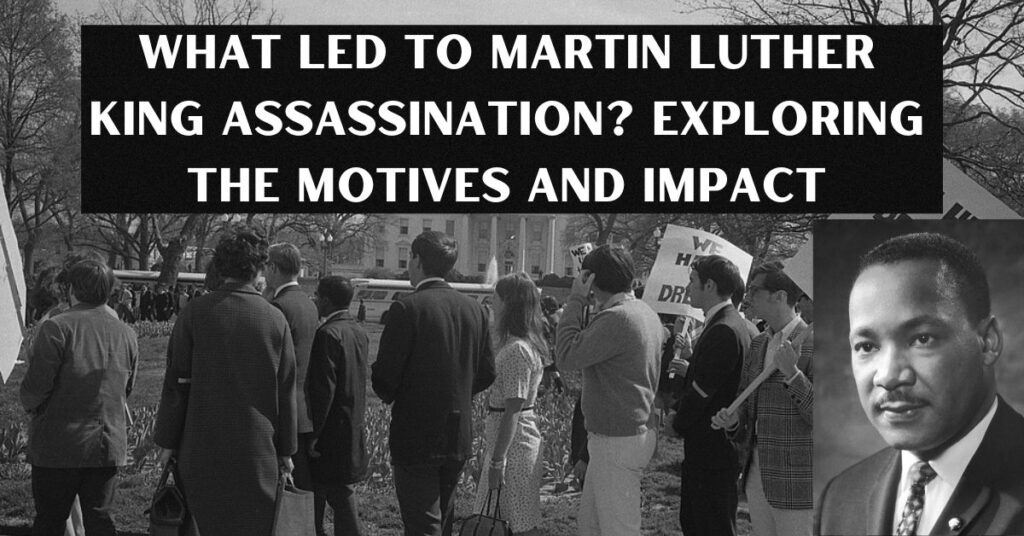What led to Martin Luther King assassination? Martin Luther King Jr. was tragically assassinated on April 4, 1968, in Memphis, Tennessee, by James Earl Ray, a man with a criminal background and a desire to halt the civil rights movement.
In this article, we’ll take a deep dive into the life and legacy of Martin Luther King Jr., a pivotal figure in American history and the civil rights movement. We’ll explore the events leading up to his tragic assassination, the motives behind it, and its enduring impact on society. Along the way, we’ll touch on King’s groundbreaking work for civil rights, the key speeches that defined his career, and the lasting influence he has had on human rights movements around the world. So, grab a cup of your favorite beverage, get comfy, and join us as we journey through the life, achievements, and untimely death of this inspiring leader.
Table of Contents
Who was Martin Luther King Jr.?
Before delving into the details of Martin Luther King Jr.’s assassination, it’s essential to understand who this remarkable man was and what he stood for. In this section, we’ll explore King’s upbringing, education, and early influences that helped shape the visionary civil rights leader he became. We’ll also take a look at some of the most significant moments in his civil rights activism, highlighting the key events and organizations that played a crucial role in his fight for equality. So, let’s turn back the clock and get to know the man behind the legend – Martin Luther King Jr.

Early life and family background
Martin Luther King Jr. was born on January 15, 1929, in Atlanta, Georgia, to a family deeply rooted in the African American community and the Baptist church. His father, Martin Luther King Sr., was a pastor at the Ebenezer Baptist Church, and his mother, Alberta Williams King, was a choir director and accomplished organist. King was the middle child, with an older sister, Christine, and a younger brother, Alfred Daniel.
Growing up in Atlanta’s Sweet Auburn neighborhood, a thriving hub for Black-owned businesses and cultural life, King was exposed to racial segregation from an early age. His parents played a crucial role in shaping his values, instilling in him a strong sense of self-worth and the importance of fighting against racial injustice.
Despite the challenges of the Jim Crow South, King’s family provided a supportive environment that nurtured his intellect and curiosity. His maternal grandfather, Reverend A.D. Williams, was a prominent minister and civil rights activist who passed on his passion for social justice to his grandson. King’s early experiences with family and community would go on to form the foundation of his commitment to the fight for civil rights, paving the way for the iconic leader he would become.
Education and influences
Martin Luther King Jr.’s education played a pivotal role in shaping his worldview and approach to activism. He attended Booker T. Washington High School, where he excelled academically and became involved in public speaking and debate. Despite encountering racial prejudice in the education system, King’s determination to succeed saw him skip both the ninth and twelfth grades, entering Morehouse College at the young age of 15.
While at Morehouse, King was deeply influenced by the college’s president, Dr. Benjamin E. Mays, an outspoken advocate for racial equality. Mays exposed King to the works of thinkers like Mahatma Gandhi, whose philosophy of nonviolent resistance would later become a cornerstone of King’s own activism. In 1948, King graduated from Morehouse with a bachelor’s degree in sociology.
Continuing his education, King enrolled at Crozer Theological Seminary in Pennsylvania, where he further honed his skills as a speaker and deepened his understanding of theology. His studies introduced him to the works of theologians and philosophers like Reinhold Niebuhr, whose ideas about social justice and the role of the church in addressing societal issues resonated with King. He graduated with a Bachelor of Divinity degree in 1951, and then pursued a Ph.D. in Systematic Theology at Boston University.
It was in Boston where King met his future wife, Coretta Scott, a talented singer and fellow civil rights activist. The couple married in 1953 and went on to have four children. Throughout their life together, Coretta played an indispensable role in supporting and amplifying King’s work in the civil rights movement.
King’s education and the influences he encountered along the way not only enriched his mind but also equipped him with the intellectual tools, rhetorical prowess, and philosophical grounding that would prove invaluable in his fight for racial equality and social justice.
Civil rights activism
Martin Luther King Jr.’s civil rights activism began in earnest when he became the pastor of Dexter Avenue Baptist Church in Montgomery, Alabama, in 1954. It wasn’t long before he was thrust into the national spotlight, playing a pivotal role in the fight against racial segregation in the United States. Let’s take a closer look at two significant events that defined King’s early activism: the Montgomery Bus Boycott and the founding of the Southern Christian Leadership Conference (SCLC).
Montgomery Bus Boycott
The Montgomery Bus Boycott was sparked by the arrest of Rosa Parks on December 1, 1955, after she refused to give up her seat to a white passenger on a segregated bus. This act of defiance galvanized the African American community in Montgomery to take a stand against the injustices of segregation.
King, then just 26 years old, was chosen to lead the Montgomery Improvement Association (MIA), which organized and coordinated the boycott. He quickly became the public face of the movement, delivering impassioned speeches and rallying support from both the Black community and sympathetic white allies.
For over a year, African Americans in Montgomery refused to ride the buses, walking or carpooling instead. The boycott put immense financial pressure on the bus company, while also garnering national attention for the civil rights struggle. Ultimately, on November 13, 1956, the Supreme Court ruled that bus segregation was unconstitutional, marking a significant victory for the movement and cementing King’s reputation as a leader.
Southern Christian Leadership Conference (SCLC)
Inspired by the success of the Montgomery Bus Boycott, King and other civil rights leaders sought to capitalize on the momentum by forming a new organization, the Southern Christian Leadership Conference (SCLC), in 1957. The SCLC aimed to unite local civil rights groups and coordinate their efforts to end segregation and achieve racial equality through nonviolent means.
As the first president of the SCLC, King worked tirelessly to promote its mission, traveling the country to give speeches, raise funds, and organize demonstrations. Under King’s leadership, the SCLC played a critical role in the civil rights movement, spearheading major campaigns and inspiring grassroots activism across the nation.
These early successes in King’s civil rights activism laid the groundwork for the broader movement that would sweep the United States, challenging and ultimately dismantling the system of racial segregation that had prevailed for generations.
What did Martin Luther King do for the civil rights movement?
As we delve deeper into Martin Luther King Jr.’s remarkable impact on the civil rights movement, it’s essential to examine the specific actions he took and the role he played in driving change. In this section, we’ll discuss some of the most notable events, campaigns, and achievements that defined King’s involvement in the movement, from his iconic “I Have a Dream” speech to the groundbreaking legislation he helped to inspire. Join us as we explore the indelible mark Martin Luther King Jr. left on the fight for racial equality and justice in the United States.

Nonviolent protest strategies
One of Martin Luther King Jr.’s most enduring legacies in the civil rights movement is his commitment to nonviolent protest strategies. Drawing inspiration from Mahatma Gandhi and his philosophy of nonviolent resistance, King firmly believed that peaceful demonstrations and civil disobedience were the most effective means to combat racial injustice.
King’s emphasis on nonviolence served multiple purposes. Firstly, it helped to minimize the risk of violent retaliation against protesters, which could derail the movement’s progress. Secondly, nonviolent protest tactics often highlighted the cruelty and inhumanity of segregationist policies, generating sympathy and support from the broader American public.
Some of the most notable nonviolent protest strategies employed during the civil rights movement under King’s guidance include:
- Sit-ins: Activists would sit down at segregated lunch counters or other public spaces, refusing to leave until they were served or forcibly removed. These sit-ins effectively disrupted business operations and drew attention to the injustice of segregation.
- Freedom Rides: In 1961, interracial groups of activists known as “Freedom Riders” traveled on interstate buses throughout the South to challenge segregated transportation facilities. Despite facing violence and arrests, the Freedom Rides ultimately led to the desegregation of interstate travel.
- Marches and mass demonstrations: Large-scale gatherings, such as the 1963 March on Washington and the 1965 Selma to Montgomery marches, brought thousands of people together to demand civil rights and voting rights for African Americans.
These nonviolent protest strategies proved highly effective in the fight for civil rights. By refusing to engage in violence, King and his followers maintained the moral high ground and focused the nation’s attention on the urgent need for change. This approach not only played a significant role in the successes of the civil rights movement but also left a lasting impact on subsequent social justice movements around the world.
Key speeches and writings
Martin Luther King Jr.’s profound impact on the civil rights movement can also be attributed to his exceptional skills as an orator and writer. Through his speeches and writings, King was able to articulate the aspirations and grievances of African Americans, rallying support for the movement and inspiring countless individuals to join the fight for racial justice. Let’s take a closer look at two of King’s most iconic and influential works: the “I Have a Dream” speech and the “Letter from Birmingham Jail.”
“I Have a Dream” speech
Delivered on August 28, 1963, during the March on Washington for Jobs and Freedom, King’s “I Have a Dream” speech is arguably his most famous and enduring work. Addressing a crowd of over 250,000 people, King passionately called for an end to racism in America and envisioned a future where all citizens, regardless of race, would be treated equally.
The speech’s most memorable passage, in which King repeatedly declared, “I have a dream,” captivated the nation and became a defining moment in the civil rights movement. The soaring rhetoric and powerful imagery of the speech are still celebrated today as symbols of hope, unity, and the ongoing struggle for equality.
“Letter from Birmingham Jail”
On April 16, 1963, while imprisoned in Birmingham, Alabama, for participating in nonviolent protests, King penned his famous “Letter from Birmingham Jail.” The letter was a response to a group of white clergymen who had criticized King’s tactics and urged him to pursue a more gradual approach to civil rights reform.
In the letter, King eloquently defended his decision to engage in nonviolent direct action, arguing that African Americans could no longer afford to wait patiently for their rights. He also criticized the complacency of white moderates, urging them to recognize the urgency of the situation and actively support the fight for racial justice.
“Letter from Birmingham Jail” remains a seminal text in the history of civil rights activism, laying out the moral and philosophical underpinnings of the movement and challenging readers to confront the systemic injustices faced by African Americans.
Together, the “I Have a Dream” speech and the “Letter from Birmingham Jail” showcase King’s ability to communicate the essence of the civil rights struggle in a way that resonated with people from all walks of life. These works not only shaped the movement but also continue to inspire and educate future generations about the ongoing fight for equality and justice.
Major civil rights campaigns
Throughout the civil rights movement, Martin Luther King Jr. played a crucial role in organizing and leading several major campaigns aimed at dismantling segregation and achieving equality for African Americans. In this section, we will explore three such campaigns – the Albany Movement, the Birmingham Campaign, and the Selma to Montgomery March – and examine how they contributed to the overall progress of the movement.
Albany Movement
The Albany Movement was a coalition of civil rights organizations, including the Southern Christian Leadership Conference (SCLC) led by King, that joined forces in 1961 to challenge racial segregation in Albany, Georgia. The movement involved a series of nonviolent protests, sit-ins, and voter registration drives intended to desegregate public facilities and empower African American citizens.
Although the Albany Movement did not result in immediate desegregation or widespread change, it did lay the groundwork for future campaigns and taught valuable lessons about the importance of strategic planning and media coverage.
Birmingham Campaign
In 1963, King and the SCLC launched the Birmingham Campaign, a series of coordinated protests and acts of civil disobedience targeting the deeply ingrained segregationist policies in Birmingham, Alabama. The campaign employed various nonviolent tactics, including sit-ins, boycotts, and marches, to pressure local businesses and government officials to end segregation.
One of the most notable aspects of the Birmingham Campaign was the use of children and young people in the protests, which came to be known as the “Children’s Crusade.” The brutal response of the police, including the use of dogs and fire hoses against the peaceful protesters, garnered widespread media attention and public outrage, ultimately leading to the desegregation of Birmingham’s public facilities.
Selma to Montgomery March
The Selma to Montgomery March was a pivotal event in the struggle for voting rights for African Americans. In March 1965, King and other civil rights leaders led thousands of protesters on a 54-mile march from Selma to Montgomery, Alabama, to demand an end to voter suppression and the passage of federal voting rights legislation.
The marchers faced significant opposition, including violent attacks from state troopers and local law enforcement. The televised images of the violence shocked the nation and spurred the federal government to intervene. The Selma to Montgomery March played a crucial role in the eventual passage of the Voting Rights Act of 1965, which prohibited racial discrimination in voting.
These major civil rights campaigns, led or supported by Martin Luther King Jr., were instrumental in challenging the system of racial segregation and discrimination that plagued the United States. Each campaign contributed to the gradual dismantling of segregation, the empowerment of African American citizens, and the advancement of the civil rights movement as a whole.
Martin Luther King’s Assassination
As we delve into the tragic and transformative event that brought an abrupt end to Martin Luther King Jr.’s life, it’s essential to understand the context in which it occurred and the impact it had on the civil rights movement and beyond. In this section, we will explore the circumstances surrounding King’s assassination, the motives of his assassin, James Earl Ray, and the profound effect his death had on the ongoing struggle for racial equality in the United States.

Timeline of events leading up to the assassination
To fully grasp the gravity of Martin Luther King Jr.’s assassination, it’s crucial to understand the series of events that led up to that fateful day. The following timeline provides an overview of the critical moments preceding King’s untimely death:
March 28, 1968: King travels to Memphis, Tennessee, to support a strike by African American sanitation workers protesting low wages and poor working conditions. A march he leads on this day ends in violence and chaos, a rare occurrence for an event organized by King.
April 3, 1968: In Memphis, King delivers his prophetic “I’ve Been to the Mountaintop” speech, in which he seems to foreshadow his own death: “I’ve seen the Promised Land. I may not get there with you. But I want you to know tonight, that we, as a people, will get to the Promised Land.”
April 4, 1968: At 6:01 p.m., Martin Luther King Jr. is fatally shot while standing on the balcony of the Lorraine Motel in Memphis. He is rushed to St. Joseph’s Hospital, where he is pronounced dead at 7:05 p.m. The news of his assassination triggers an outpouring of grief and anger, leading to riots and civil unrest in more than 100 cities across the United States.
April 6, 1968: James Earl Ray, an escaped convict with a history of petty crimes, is identified as the prime suspect in King’s assassination after fingerprints found on the alleged murder weapon and a nearby abandoned bundle are traced back to him.
April 8, 1968: A massive silent march, led by King’s widow, Coretta Scott King, takes place in Memphis to honor his memory and continue his work.
June 8, 1968: After an international manhunt, James Earl Ray is captured in London’s Heathrow Airport, where he is trying to flee to Belgium using a fake Canadian passport.
These events paint a vivid picture of the tense atmosphere and mounting pressure leading up to Martin Luther King Jr.’s assassination. The ensuing fallout from his death would have a lasting impact on both the civil rights movement and American society as a whole.
Assassination location and circumstances
The assassination of Martin Luther King Jr. took place at the Lorraine Motel in Memphis, Tennessee, a location that has since become synonymous with this tragic event in American history. To fully comprehend the circumstances surrounding King’s assassination, it’s essential to delve into the details of the fateful day.
Lorraine Motel
The Lorraine Motel, located at 450 Mulberry Street in Memphis, was a popular gathering place for African American musicians and civil rights activists during the 1960s. On April 4, 1968, King was staying in room 306 of the motel, which he often used as a base when visiting Memphis.
Circumstances of the Assassination
On the evening of April 4, King was preparing to attend a dinner at the home of a local minister, Reverend Samuel “Billy” Kyles. At around 6:00 p.m., he stepped out onto the balcony of room 306 to chat with his colleagues, who were waiting in the parking lot below. It was at this moment, at 6:01 p.m., that a single shot rang out.
The bullet struck King in the face, severing his spinal cord and causing massive internal injuries. His friends and associates rushed to his side, but it was clear that his wounds were fatal. He was rushed to St. Joseph’s Hospital, where he was pronounced dead at 7:05 p.m.
The Shooter’s Location
James Earl Ray, the man who would later be convicted of King’s assassination, fired the shot from a small, shared bathroom in a rooming house across the street from the Lorraine Motel. Ray had rented a room in the building under the alias “John Willard” and used a high-powered rifle to carry out the assassination.
The Lorraine Motel and the tragic events that unfolded there on April 4, 1968, have left an indelible mark on American history. Today, the motel has been transformed into the National Civil Rights Museum, ensuring that the legacy of Martin Luther King Jr. and the struggle for civil rights will never be forgotten.
Immediate aftermath and public reaction
The immediate aftermath of Martin Luther King Jr.’s assassination sent shockwaves throughout the United States and the world. As news of his death spread, people from all walks of life mourned the loss of this influential civil rights leader. In this section, we’ll explore the public reaction and the events that followed in the days and weeks after King’s death.
Public Reaction
King’s assassination was met with a mix of profound grief, shock, and anger. For many, he was a beacon of hope in the fight against racial inequality and injustice, and his death left a void that seemed impossible to fill. Vigils, memorial services, and tributes took place across the nation as people mourned and tried to make sense of the tragedy.
Civil Unrest and Riots
The grief and anger sparked by King’s assassination led to widespread civil unrest and riots in over 100 cities across the United States. The violence and destruction left many communities in turmoil, and the National Guard was deployed to restore order in some of the hardest-hit areas. These events highlighted the deep racial tensions and divisions that still existed in America.
The Call for Nonviolence
In the wake of the violence, many civil rights leaders and King’s family members urged people to honor his legacy by remaining committed to nonviolent protest. King’s widow, Coretta Scott King, played a pivotal role in maintaining this message, leading a silent march in Memphis just four days after her husband’s death.
Political Impact
The assassination of Martin Luther King Jr. had a significant impact on American politics. President Lyndon B. Johnson called for a national day of mourning and renewed his commitment to passing civil rights legislation. In response to the riots and unrest, Johnson signed the Civil Rights Act of 1968, also known as the Fair Housing Act, which prohibited discrimination in housing based on race, religion, or national origin.
The public reaction and immediate aftermath of King’s assassination underscored both the tremendous impact he had on the civil rights movement and the deep divisions that persisted in American society. His death marked the end of an era, but his message of nonviolence and the pursuit of equality continued to resonate in the years to come.
.
Who was James Earl Ray and why did he shoot King?
In this section, we’ll explore the background and motivations of James Earl Ray, the man convicted of assassinating Martin Luther King Jr. Understanding who Ray was and the factors that drove him to commit such a heinous act sheds light on a dark chapter in American history. We’ll delve into Ray’s personal history, his criminal past, and the evidence that led to his arrest and conviction, as well as the theories surrounding his motivations for killing King

Background and criminal history
James Earl Ray was born on March 10, 1928, in Alton, Illinois. He grew up in a poor family and experienced a troubled childhood, marked by frequent moves and an unstable home life. Ray dropped out of school at a young age and turned to a life of crime, with a rap sheet that included burglaries, armed robberies, and other petty offenses. He served multiple stints in prison, and in 1967, he managed to escape from the Missouri State Penitentiary, setting the stage for the events that would lead to King’s assassination.
Motives for assassinating King
While the exact motives behind Ray’s decision to assassinate Martin Luther King Jr. remain unclear, several factors are thought to have contributed to his actions. Ray harbored racist beliefs and was known to have expressed admiration for Adolf Hitler. He may have viewed King’s efforts to promote racial equality as a threat to his own white supremacist ideology. Additionally, there were reports that Ray believed he could gain notoriety and financial reward by killing a high-profile figure like King. Lastly, some conspiracy theories suggest that Ray may have been part of a broader plot involving other individuals or groups, though these theories remain unproven.
Evidence and trial
The investigation into King’s assassination led authorities to James Earl Ray, who had fled the country and was eventually apprehended in London on June 8, 1968. Key pieces of evidence linking Ray to the crime included the rifle used in the shooting, which was found near the crime scene with Ray’s fingerprints on it, and eyewitness accounts placing him at a boarding house from which the shot was fired. Additionally, Ray had purchased the rifle and other items under an alias that was traced back to him.
Ray initially confessed to the assassination and pleaded guilty in order to avoid the death penalty. He was sentenced to 99 years in prison. However, he later recanted his confession and claimed that he was merely a pawn in a larger conspiracy, though he never provided any concrete evidence to support his claims. Ray spent the rest of his life attempting to secure a new trial, but his efforts were unsuccessful. He died in prison in 1998 at the age of 70.
How old was Martin Luther King when he died?
In this section, we’ll discuss the age of Martin Luther King Jr. at the time of his tragic assassination. While King’s life was cut short, his legacy and impact on the civil rights movement and American society continue to be celebrated and recognized today. By understanding his age at the time of his death, we can gain a deeper appreciation for the remarkable achievements he made in such a short time and the potential he had for even greater accomplishments had he lived longer.

Age at the time of assassination
Martin Luther King Jr. was assassinated on April 4, 1968, at the age of 39. He was in Memphis, Tennessee, to support a strike by sanitation workers when he was fatally shot while standing on the balcony of the Lorraine Motel. Despite his relatively young age, King had already made significant contributions to the civil rights movement and played a crucial role in advancing racial equality in the United States.
Impact of his age on his legacy
The fact that Martin Luther King Jr. achieved so much in his 39 years is a testament to his dedication, passion, and leadership. His young age at the time of his death highlights the potential for even more significant accomplishments had he been given more time. King’s untimely death also underscores the urgency and importance of the civil rights movement, as well as the personal sacrifices made by those who fought for equality.
In the years since his assassination, King’s legacy has continued to grow and inspire new generations of activists and leaders. His speeches, writings, and acts of nonviolent protest have become a blueprint for social change and are studied and admired worldwide. While King’s life was tragically cut short, his impact on American society and the fight for civil rights has proven to be enduring and profound.
Where did Martin Luther King live and work?
Throughout his life, Martin Luther King Jr. lived and worked in several key locations, which played significant roles in the development of his activism and the civil rights movement as a whole. In this section, we will explore some of the most important places where King lived and worked, including Atlanta, Georgia; Montgomery, Alabama; Birmingham, Alabama; and Chicago, Illinois.
Atlanta, Georgia
Martin Luther King Jr. was born on January 15, 1929, in Atlanta, Georgia. He spent much of his early life in the city, where his father, Martin Luther King Sr., was a prominent Baptist minister. King attended Morehouse College in Atlanta, where he developed his passion for social justice and civil rights. Later, he served as co-pastor of Ebenezer Baptist Church with his father. Atlanta remained an important base for King throughout his life, and it is where his tomb is now located at the Martin Luther King Jr. National Historical Park.
Montgomery, Alabama
King’s involvement in the civil rights movement escalated during his time in Montgomery, Alabama. In 1954, King became the pastor of Dexter Avenue Baptist Church in Montgomery. The following year, he emerged as a leader during the Montgomery Bus Boycott, which began after Rosa Parks was arrested for refusing to give up her bus seat to a white passenger. The boycott lasted 381 days, and its success led to the formation of the Southern Christian Leadership Conference (SCLC) in 1957, with King as its first president.
Birmingham, Alabama
Birmingham, Alabama, was another critical battleground in the fight for civil rights. In 1963, King and the SCLC launched the Birmingham Campaign, a series of nonviolent protests aimed at desegregating the city’s public facilities and ending discriminatory hiring practices. The campaign’s events, including the violent response from law enforcement, captured national attention and helped lead to the passage of the Civil Rights Act of 1964.
Chicago, Illinois
In 1966, King and the SCLC shifted their focus to the North, targeting racial inequality in Chicago, Illinois. King moved his family to a tenement in a low-income neighborhood on the city’s West Side to highlight the poor living conditions faced by African Americans. The Chicago Freedom Movement, as it came to be known, aimed to address issues such as housing discrimination, inadequate education, and economic injustice. While the campaign faced numerous challenges, it raised awareness of systemic racism beyond the South and influenced subsequent civil rights efforts.
Throughout his life, Martin Luther King Jr. lived and worked in various locations, each contributing to his activism and the broader civil rights movement. His presence in these cities left an indelible mark on American history and continues to inspire future generations to strive for justice and equality.

Image Credit: By Mikefairbanks
Legacy of Martin Luther King Jr.
The impact of Martin Luther King Jr.’s life and work extends far beyond his untimely death. His tireless dedication to the fight for civil rights and social justice has left an enduring legacy that continues to inspire people around the world. In this section, we will explore King’s influence on the civil rights movement and his worldwide impact on human rights.
Influence on the civil rights movement
Martin Luther King Jr.’s leadership during the civil rights movement was transformative, as he successfully employed nonviolent strategies to challenge segregation and discrimination in the United States. His role in key events, such as the Montgomery Bus Boycott, the Birmingham Campaign, and the Selma to Montgomery March, led to significant advancements in racial equality. King’s insistence on nonviolence helped to create a moral contrast between the peaceful protesters and the often brutal response from authorities. This approach not only garnered national and international attention but also contributed to the passage of landmark legislation, including the Civil Rights Act of 1964 and the Voting Rights Act of 1965.
Worldwide impact on human rights
King’s influence extends beyond the United States and has had a profound effect on human rights movements around the world. His philosophy of nonviolent resistance has inspired countless activists and social movements, including the anti-apartheid struggle in South Africa, the fight for democracy in Eastern Europe, and the quest for social justice in Latin America, among others. King’s speeches and writings, particularly “I Have a Dream” and the “Letter from Birmingham Jail,” have been translated into numerous languages and continue to resonate with people of all backgrounds.
Additionally, King’s legacy has been commemorated in various ways. In the United States, Martin Luther King Jr. Day is observed annually on the third Monday of January to honor his contributions to the nation’s civil rights advancements. Monuments, streets, and schools have been named after him across the globe, and the Nobel Peace Prize he received in 1964 serves as a testament to his lasting impact.
The legacy of Martin Luther King Jr. continues to inspire and empower people in the pursuit of social justice, equality, and human rights. His unwavering commitment to nonviolent activism and his powerful message of love and hope have left an indelible mark on history, proving that one person’s vision can truly change the world.
Conspiracy theories surrounding Martin Luther King’s assassination
The assassination of Martin Luther King Jr. has spawned numerous conspiracy theories over the years, with some questioning the official narrative of the events surrounding his death. In this section, we will delve into some of the most prominent conspiracy theories, including allegations of government involvement, James Earl Ray’s retractions and appeals, and the stance of the King family on the case.
Allegations of government involvement
One of the most persistent conspiracy theories surrounding King’s assassination suggests that the U.S. government, particularly the FBI, played a role in orchestrating his death. Proponents of this theory argue that the government, under the leadership of then-FBI Director J. Edgar Hoover, had long been hostile toward King due to his activism and influence. This theory is fueled by the documented surveillance and harassment of King by the FBI and claims that the government saw King as a threat to national security.
James Earl Ray’s retractions and appeals
James Earl Ray, the man convicted of assassinating King, initially confessed to the crime but later recanted his confession. Over the years, Ray appealed his conviction multiple times, claiming that he was a scapegoat in a larger conspiracy involving a mysterious figure named “Raoul” who allegedly framed him for the murder. Ray’s appeals were ultimately unsuccessful, and he died in prison in 1998. Nonetheless, his retractions and allegations of being set up have continued to fuel conspiracy theories.
The King family’s stance on the case
Adding to the intrigue surrounding the assassination, members of the King family have expressed doubts about the official account of King’s murder. Some family members have publicly supported the theory that Ray was not the actual killer but a patsy in a larger conspiracy. In 1999, the King family won a civil lawsuit against Loyd Jowers, a Memphis businessman who claimed that he had been involved in a conspiracy to kill King. The jury in the case found that Jowers and “others, including governmental agencies,” were part of a conspiracy to assassinate King. However, the verdict has been met with skepticism from some legal experts and historians.
The conspiracy theories surrounding Martin Luther King Jr.’s assassination have persisted for decades, with various claims and counterclaims continuing to spark debate. While the official narrative attributes King’s death to James Earl Ray, questions about the involvement of other parties, including the U.S. government, remain a subject of fascination and speculation for many.
Conclusion
In conclusion, Martin Luther King Jr.’s life and legacy as a civil rights leader continue to inspire and influence people around the world. From his early life and education to his impassioned speeches and nonviolent protest strategies, King’s unwavering commitment to achieving racial equality in America remains a cornerstone of the civil rights movement. While his assassination and the subsequent conspiracy theories surrounding it have added a layer of mystery and controversy to his story, the impact of his work and the ideals he championed endure. As we remember and celebrate the life of Martin Luther King Jr., it is essential to continue striving for justice, equality, and understanding in his honor.

Joyce Ann Tyldesley is a renowned British archaeologist, Egyptologist, writer, and broadcaster.






